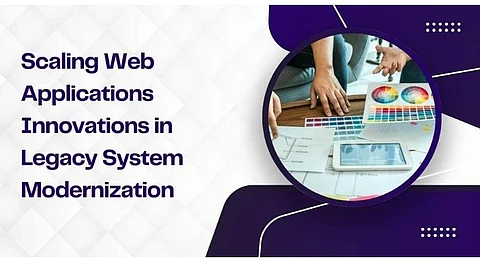

Legacy system modernization has become a necessity in today’s fast-paced digital era. Murali Ajit Varma, an expert in web application scalability, explores strategies for transforming outdated systems into high-performing, future-ready applications. His insights provide a structured approach to modernization, ensuring efficiency, security, and scalability.
Before embarking on modernization, organizations must evaluate their existing systems to identify technical debt, security vulnerabilities, and performance bottlenecks. Research indicates that nearly 70% of IT budgets are spent on maintaining outdated systems, leaving little room for innovation. A structured assessment can significantly reduce maintenance costs while improving system reliability. Legacy applications often rely on outdated programming languages and frameworks, making them difficult to integrate with modern technologies. A thorough audit of system dependencies, infrastructure, and code quality is crucial to developing an effective modernization roadmap.
Traditional monolithic systems often struggle with adaptability. Organizations can enhance flexibility and reduce downtime by transitioning to modular architectures using microservices. Microservices enable independent scaling of components, facilitating faster updates and improved performance. Studies show that companies adopting microservices can deploy updates up to 30 times more frequently than those using monolithic structures. Additionally, microservices support distributed development, allowing teams to work on various application components simultaneously. This approach accelerates innovation and minimizes disruptions caused by system-wide updates. Furthermore, organizations implementing microservices report significant cost savings, as they can optimize resource allocation and minimize inefficiencies associated with large-scale system overhauls.
Cloud infrastructure plays a pivotal role in modernizing legacy systems. By migrating applications to the cloud, organizations benefit from reduced operational costs, enhanced security, and improved scalability. Cloud-native designs incorporate containerization, event-driven architectures, and Infrastructure as Code (IaC), enabling consistent deployment across various environments. Cloud platforms also offer built-in redundancy and disaster recovery solutions, ensuring business continuity. Moreover, cloud migration enables businesses to adopt a pay-as-you-go model, optimizing resource utilization while reducing unnecessary expenditures. Additionally, cloud-based solutions facilitate remote access and collaboration, making it easier for teams to manage and maintain applications efficiently.
APIs are the foundation for modern web applications, promoting seamless integration between different services. Effective API management strategies include clear documentation, version control, and security protocols to ensure smooth communication. Organizations that prioritize API governance report fewer security incidents and reduced integration challenges. API gateways provide an added layer of security by monitoring access, implementing rate limiting, and encrypting sensitive data. As digital ecosystems expand, API management becomes crucial in enabling third-party integrations and fostering platform interoperability. Well-structured APIs help organizations future-proof their applications by ensuring adaptability to evolving business requirements.
In the age of transition, security continues to be a matter of concern. This is none other than because one can manage a wide range of antitheft technologies – encryption, authentication, authorization. Ensure regulatory is maintained by ensuring compliance to the likes of General Protection Regulation (GDPR), Health Insurance Portability and Accountability Act (HIPAA), and Payment Card Industry Data Security Standard (PCI DSS) etc. Also, when addressing the issue of cyber security, it is important to cover the modern prerequisites such as real-time threat monitoring, on-time security updates, and everything or anything else that may help in ensuring security. Measures such as immediate enforcement of proper Multi-Factor require very strong and secure configurations of how users authenticate, which if not maintained directs an traffic into another common security issue. Even this is not enough. Such routers make it possible even to anticipate possible intrusions, and take appropriate steps to prevent them.
System efficiency in maintaining the newly modernized platforms is largely facilitated by automated procedures. Continuous Integration (CI) and Continuous Deployment (CD) processes are a key aspect in the software development cycle, making it possible to seamlessly undertake several versions without many urging fearing of breaking the system. Robotics Test Automation tools are employed to avoid performance or security issues before a new version is released. Also, in an application-centric world, the exact health of an application or a set of applications can be easily known and problems corrected in time through this form of layered monitoring. Business establishments that adopt automation measures see minimized downtimes, increase in performance levels and improved user interaction over time. Furthermore, machine learning techniques enable early prediction of breakdowns and planning of preventive maintenance to minimize operational inadequacies.
Modernization is not simply an upgrading of the technology-it's, future-proofing businesses-scales applications into the web dynamic user demands solicits operational efficiencies and inspires innovation. Organizations develop long-haul strategies to ensure business resilience in times of change through strategic modernization. They can become even more efficient with applications that are enhanced with emerging technologies like artificial intelligence (AI), machine learning (ML), and so on to properly provision resources needed by the systems as well as predict abnormal activities in the systems. This greatly benefits from the emergence of edge computing, which helps centralize processing and raises response time while reducing congestion on networks. Further, blockchain is gaining popularity in modernized web applications as a way of ensuring data and secure transactions.
In conclusion, Murali Ajit Varma's skills represent an achievable way for organizations toward transforming legacy systems into high-performing web applications. The path to modernization is not difficult using right strategies for a company to benefit from using its investment. Investing in modern digital transformation today guarantees growth and sustains competitive advantage in the future technological landscape.
